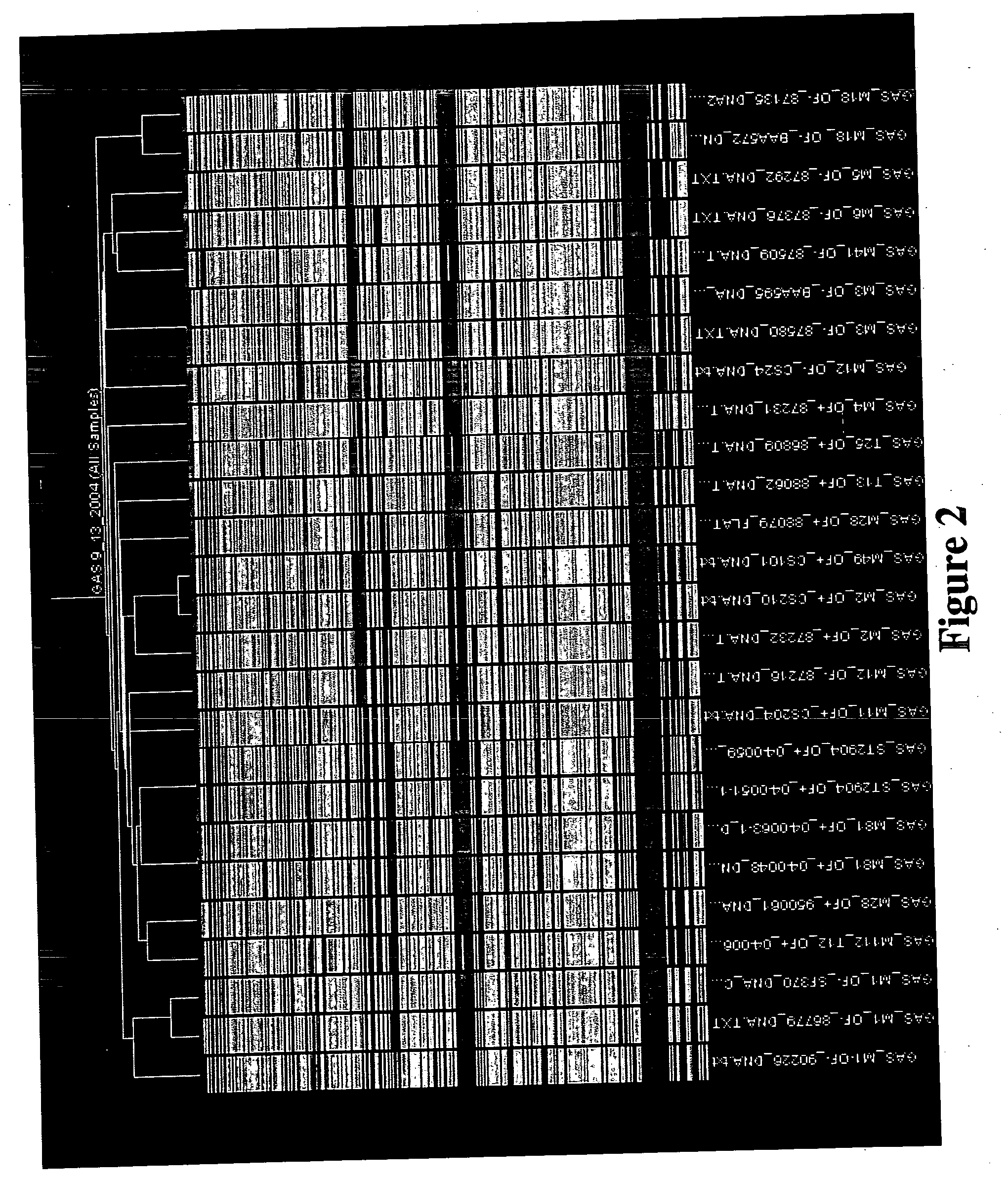Probe arrays for detecting multiple strains of different species
a technology of arrays and probes, applied in the field of probe arrays, can solve the problems of many methods that enable the identification of i>staphylococcus aureus /i>strains, fail to identify i>staphylococcus epidermidis, misidentification, etc., and achieve the effects of reducing virulence, reducing virulence, and modulating gene expression in the pathogen
- Summary
- Abstract
- Description
- Claims
- Application Information
AI Technical Summary
Benefits of technology
Problems solved by technology
Method used
Image
Examples
example 1
Nucleic Acid Array
The parent sequences depicted in SEQ ID NOs: 1-18,598 and / or their sequence segments were submitted to Affymetrix for custom array design. Probes with 25 non-ambiguous bases were selected. The final set of selected probes is depicted in SEQ ID NOs: 605,358 to 1,276,209. The specificity of each probe to different strains of Streptococcus pyogenes, Streptococcus agalactiae or Staphylococcus epidermidis is also indicated in SEQ ID NOs: 605,358 to 1,276,209 (see supra).
The perfect mismatch probe for each probe in SEQ ID NOs: 605,358 to 1,276,209 was also prepared. A perfect mismatch probe is identical to the corresponding perfect match probe except at position 13 where a single-base substitution was made. The substitutions were A to T, T to A, G to C, or C to G. The final array contains 673,599 perfect match probes and 673,599 mismatch probes, which include 10,761 Streptococcus probe sets, 7,740 Staphylococcus probe sets, and a number of exogenous control probe set...
example 2
Analysis of the Accuracy of the Nucleic Acid Array of Example 1
An analysis can be conducted to confirm the performance of the nucleic acid array of Example 1 with respect to sequenced Streptococcus pyogenes, Streptococcus agalactiae and Staphylococcus epidermidis genomes. Each parent sequence in SEQ ID NOs: 1-18,217 is derived from the transcript(s) or intergenic sequence(s) of one or more Streptococcus pyogenes, Streptococcus agalactiae or Staphylococcus epidermidis strains. If at least 70% of the oligonucleotide probes for a parent sequence are present in the genome of a Streptococcus pyogenes, Streptococcus agalactiae or Staphylococcus epidermidis strain, then the parent sequence is theoretically predicted to be “present” in the genome of that strain. In some cases, present calls can be made on the basis of 100% of the probes being present. The theoretical predictions are compared to the actual results of DNA hybridization experiments using the nucleic acid array of Example 1 t...
example 3
Sample Preparation for Monitoring Gene Expression
Total RNA of Streptococcus pyogenes, Streptococcus agalactiae or Staphylococcus epidermidis strain(s) is isolated under a control condition or a test condition. Under the test condition, bacterial cells are either differentially treated or have a divergent genotype. cDNA is synthesized from total RNA of the control or test sample as follows. 10 μg total RNA is incubated at 70° C. with 25 ng / μl random hexamer primers for 10 min followed by 25° C. for 10 min. Mixtures are then chilled on ice. Next, 1×cDNA buffer (Invitrogen), 10 mM DTT, 0.5 mM dNTP, 0.5 U / μl SUPERase-In (Ambion), and 25 U / μl SuperScript II (Invitrogen) are added. For cDNA synthesis, mixtures are incubated at 25° C. for 10 min, then 37° C. for 60 min, and finally 42° C. for 60 min. Reactions are terminated by incubating at 70° C. for 10 min and are chilled on ice. RNA is then chemically digested by adding 1N NaOH and incubation at 65° C. for 30 min. Digestion is termin...
PUM
| Property | Measurement | Unit |
|---|---|---|
| Fraction | aaaaa | aaaaa |
| Fraction | aaaaa | aaaaa |
| Fraction | aaaaa | aaaaa |
Abstract
Description
Claims
Application Information
 Login to View More
Login to View More - R&D
- Intellectual Property
- Life Sciences
- Materials
- Tech Scout
- Unparalleled Data Quality
- Higher Quality Content
- 60% Fewer Hallucinations
Browse by: Latest US Patents, China's latest patents, Technical Efficacy Thesaurus, Application Domain, Technology Topic, Popular Technical Reports.
© 2025 PatSnap. All rights reserved.Legal|Privacy policy|Modern Slavery Act Transparency Statement|Sitemap|About US| Contact US: help@patsnap.com



